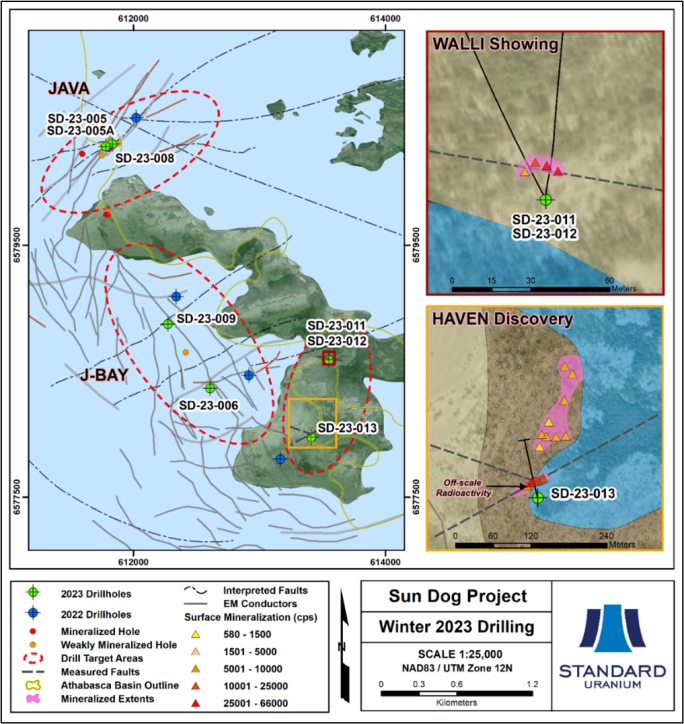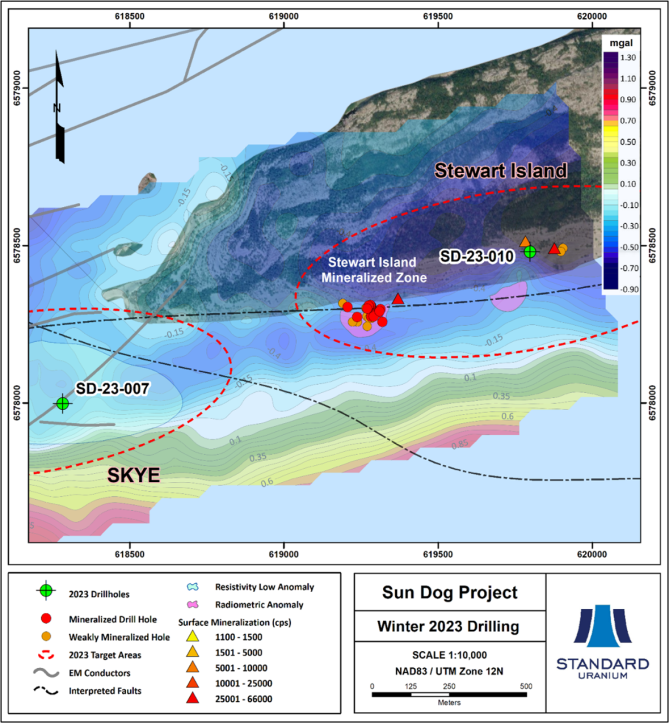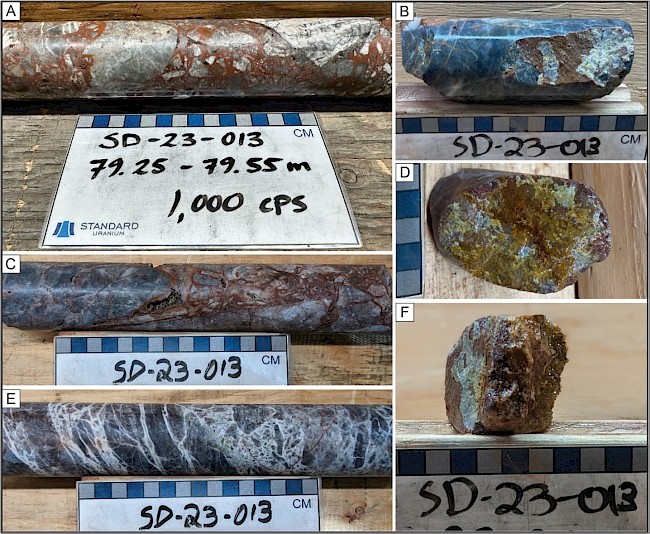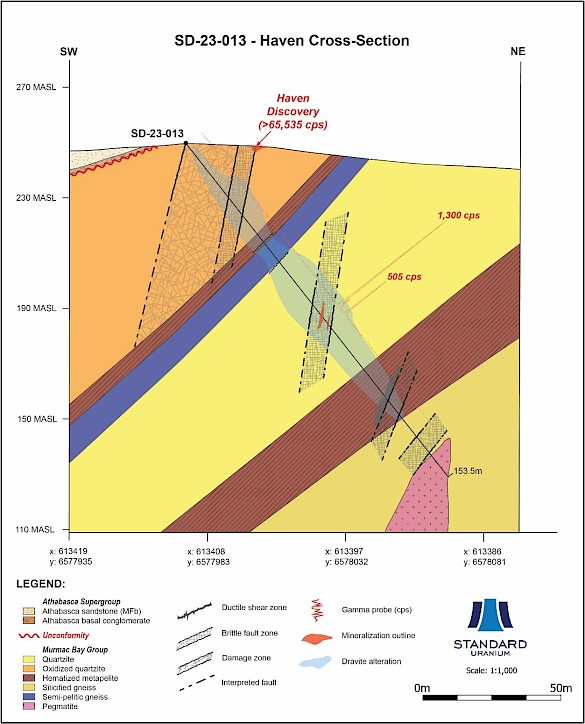Vancouver, British Columbia, October 31, 2023 — Standard Uranium Ltd. (“Standard Uranium” or the “Company”) (TSX-V: STND) (OTCQB: STTDF) (Frankfurt: FWB:9SU) is pleased to announce analytical highlights from the winter 2023 drill program at its 19,603-hectare Sun Dog Project (“Sun Dog”). Sun Dog is located at the northwestern edge of the Athabasca Basin, Saskatchewan, and is south of the first uranium mining camp in Canada, the Beaverlodge District, near Uranium City.
Key Focus Points:
- Breccia-hosted uranium mineralization intersected in the first drillhole at the Haven discovery (SD-23-013) grading up to 0.042 wt.% U3O8 over 0.5 m.
- Analytical data from Sun Dog drilling shows elevated pathfinder elements, while clay mineral spectroscopy confirms presence of significant dravite alteration in Johnston Island drill holes, expanding the alteration footprint to 900 metres x 1,600 metres at the Haven-Walli target area.
- Elevated uranium in the basement exceeds thorium values by a factor of 2 or more in multiple intervals, supporting hydrothermal uranium emplacement.
- Several high-priority drill targets have been identified for subsequent drilling, targeting high-grade unconformity-related uranium mineralization.
Winter 2023 Drill Program Analytical Highlights
Ten diamond drill holes comprising 1,227.1 m were completed in March 2023 at the Johnston Bay, Java, Haven, Walli (Figure 1), and Stewart Island (Figure 2) target areas. The program was designed to follow up on the results of the 2022 drill program, test historical high-grade uranium mineralization, and test for the down-dip extension of mineralized structures mapped at surface.
The results of the program highlight the potential for the property to host significant unconformity-related and basement-hosted uranium mineralization. Sun Dog contains several priority targets to follow up on previous drill hole intersects of uranium mineralization and basement-rooted structures that warrant further exploration. These factors, along with the presence of numerous radioactive mineral occurrences in both basement rocks and the overlying Athabasca sandstone, indicate excellent potential for economic uranium mineralization within the Sun Dog Project area. Additionally, the discovery of an extensive dravite-clay-iron oxide alteration system on Johnston Island which corresponds with elevated radioactivity, further supports the potential for shallow high-grade uranium mineralization.
Sean Hillacre, President & VP Exploration stated, “Intersecting uranium mineralization at depth in our first drill hole at Haven has the team eager to continue drilling this area. Our team and vendors did a fantastic job at Sun Dog despite the challenging winter conditions we faced, and we have significantly expanded the footprint of a robust dravite-clay-iron oxide alteration system on Johnston Island which corresponds with instances of strong radioactivity. The magnitude of the alteration halos and structural disturbance in our targets areas highlights the potential for Sun Dog to host significant high-grade mineralization. We have further refined our exploration strategy and are keen to continue exploring these targets in addition to untested mainland target areas going forward.”
“We know from our team’s experience in these styles of deposits both in the Athabasca and the Alligator Province of Northern Australia, that uranium mineralization falls off very quickly as you move away from high grade, economic deposits. Getting elevated uranium hits and significant alteration often diagnostic of mineralization is a very good sign that we’re well in the ballpark of something exciting.”

Figure 1. Plan map showing winter 2023 drill holes around Johnston Island in the Java, Johnston-Bay, Walli, and Haven target areas. Historical mineralized drill holes, geophysical conductors, interpreted faults, and surface uranium showings are highlighted.

Figure 2. Plan map of winter 2023 drill collars at Skye and Stewart Island in context of historical drill holes, surface mineralization, geophysical and radioactivity anomalies, and EM conductors.
Drill hole SD-23-012 returned 2.31 ppm uranium in silicified Athabasca sandstone (MFd) within a dm-scale quartz-hematite breccia from 9.25 to 9.40 m. Elevated uranium was also intersected in drill hole SD-23-006, returning 1.32 ppm uranium in Athabasca sandstone (MFb) with hydrothermal hematite healed fractures, local druzy quartz veins, and sooty pyrite fractures. Uranium concentrations above 1.0 ppm are considered anomalous in Athabasca sandstone.
Drill hole SD-23-013 returned the highest uranium value of 0.042 wt.% U3O8 over 0.5 m (360 ppm U, partial digest) in an oxidized fault breccia hosting clay-dravite alteration. Within the same structure, 0.021 wt.% U3O8 over 0.5 m (136 ppm U, partial digest), and 0.005 wt.% U3O8 over 1.0 m (35.2 ppm and 33.2 ppm U, partial digest) was intersected. In the sandstone and basement, elevated uranium exceeds thorium values by a factor of 2 in multiple intervals, supporting hydrothermal uranium emplacement processes.
Analytical results have been received and reviewed, with highlights outlined below:
- SD-23-013; Haven discovery (Figure 3):
-
- Down-dip follow up of fault-controlled off-scale** surface mineralization at the Haven discovery. Visible uraninite at surface.
- 0.042 wt.% U3O8 from 79.0 to 79.5 m, as well as anomalous nickel (65 ppm), arsenic (62 ppm), boron (110 ppm), lead (15 ppm), and molybdenum (1 ppm).
- 0.021 wt.% U3O8 from 79.5 to 80.0 m, as well as an anomalous 206Pb/204Pb lead isotope ratio (0.13), anomalous nickel (45 ppm), boron (158 ppm), and arsenic (32 ppm).
- 0.005 wt.% U3O8 from 82.5 to 83.5 m, in addition to anomalous boron (153 ppm).
- Weak to locally strong dravite alteration throughout, with a dravite and kaolinite peak in a deformation zone within semi-pelitic gneiss at 122 m.
- SD-23-012; Walli showing:
-
- Down-dip follow up of surface mineralization up to 45,000 cps west along strike of hole SD-23-011.
- Anomalous lithium (132 ppm), nickel (15 ppm), boron (113 ppm), and vanadium (5 ppm) in silicified upper MFd sandstone from 3.0 to 5.0 m.
- Anomalous uranium (2.31 ppm), vanadium (4 ppm), and nickel (4 ppm) from 5.0 to 9.5 m, associated with a quartz-hematite breccia from 9.25 to 9.40 m.
- Anomalous boron (2,560 ppm) and vanadium (54 ppm) in sheared pelitic gneiss from 60 to 60.1 m.
- Strong fracture-hosted dravite (83.3%) directly below the unconformity at 11 m, with additional concentrations up to 30% downhole associated with fracture zones.
- SD-23-011; Walli showing:
-
- Down-dip follow up of surface mineralization up to 45,000 cps at the Walli showing.
- Anomalous lithium (97 ppm) from 3 to 6 m, anomalous boron (524 ppm) and lithium (66 ppm) from 6 to 10 m.
- 3,810 ppm boron in hematite-altered semi-pelitic gneiss from 19.9 to 20.0 m, as well as elevated boron throughout the basement intersection.
- Anomalous lithium (138 to 274 ppm), boron (333 to 411 ppm), nickel (13 to 21 ppm), and vanadium (15 to 51 ppm) throughout the basement in association with dravite-chlorite-clay alteration.
- Up to 22% fracture-hosted dravite returned from directly above the unconformity at 10.9 m.
- Strong dravite alteration (up to 82%) associated within or proximal to brittle-reactivated shear zones and local fault breccias between 14 and 116 m, with intermittent accessory kaolinite.
- SD-23-010; Stewart Island showing:
-
- 80 m step out west along strike from mineralization (61,000 cps) at surface and down-dip test of mineralization up to 7,400 cps at surface.
- Anomalous pathfinders in the upper sandstone from 5 to 15 m, including 373 ppm boron, 21 ppm lithium, 2 ppm lead, and 9 ppm vanadium.
- Weak and locally moderate fracture- and matrix-hosted dravite at 10.80 m, 14.43 m, and 26.33 m within Athabasca sandstone.
- Anomalous lead (2 ppm), vanadium (14 ppm), and lithium (44 ppm) in the basal 30 m of conglomerate overlying the unconformity.
- Weakly anomalous boron (176 ppm) and vanadium (11 ppm) in sheared and pervasively hematite-altered banded iron formation from 127.8 to 127.9 m.
- Fracture- and matrix-hosted dravite (up to 44%) associated with brittle structures between 67 and 143 m. Fracture-hosted dravite at 67.76 m, proximal to the unconformity (63.95 m).
- SD-23-006; J-Bay target:
-
- 343 m step out southeast of mineralized drill hole LAI-05, targeting the confluence of several conductors within a gravity low gradient.
- Anomalous U (1.32 ppm) and moderately anomalous vanadium (11 ppm) in MFb sandstone from 50 to 60 m, with hydrothermal hematite-healed fractures.
- Anomalous boron (179 to 335), vanadium (7.5 to 12.6 ppm) and lithium (42 to 102 ppm) between 80 and 110 m.
- Graphitic pelitic gneiss from 251.5 to 252 m, returning anomalous molybdenum (70 ppm), cobalt (78 ppm), nickel (226 ppm), and vanadium (71 ppm).
- 1,560 ppm boron from 140.0 to 140.1 m and 867 ppm from 404.0 to 404.1 m (in addition to 11 ppm molybdenum, 13 ppm lead, 10 ppm vanadium, and a highly anomalous 206Pb/204Pb isotope ratio of 0.11).
- Weak fracture and matrix-hosted dravite returned between 208 and 223 m.

Figure 3. Core photos from drill hole SD-23-013 at the Haven discovery, highlighting significant alteration and structure associated with elevated radioactivity. All drill core is NQ diameter (47.6mm). A) Oxidized fault breccia hosting elevated radioactivity up to 1,000 cps (1,300 cps on 32GR gamma probe). B) Hematized fracture coated with blue dravite-clay alteration; Up to 100 cps, 31.05m. C) Strongly hematite-altered fault breccia with druzy quartz-siderite vugs; Up to 100 cps, 76.25m. D) Oxidized fracture surface lined with dravite-clay and limonite alteration; Up to 85 cps, 19.75m. E) Quartz-clay ± dravite-healed mosaic breccia; Up to 80 cps, 54.3m. F) Druzy quartz fracture with dravite and hematite-limonite alteration; Up to 85 cps, 22.86m.

Figure 4. Schematic cross-section highlighting uranium mineralization, geology, structure, and alteration in drill hole SD-23-013, relative to mapped surface uranium mineralization at the Haven discovery.
*The Company considers uranium mineralization with concentrations greater than 1.0 weight percent (wt%) U3O8 to be “high-grade”.
**The Company refers to off-scale radioactivity as any intersection of radioactivity reaching 65,535 counts per second or greater on a Radiation Solutions handheld RS-125 superspec or RS-120 superscint.
Samples collected for analysis are sent to Saskatchewan Research Council Geoanalytical Laboratories (“SRC”) in Saskatoon, Saskatchewan for preparation, processing and ICP-MS multi-element analysis using total and partial digestion, gold by fire assay and boron by fusion. Sandstone samples were tested using the ICP-MS1 uranium multi-element exploration package plus boron. Basement samples were tested with ICP-MS2 uranium multi-element exploration package plus boron. All sandstone samples, and basement samples marked as radioactive upon arrival to the lab were also analyzed using the U3O8 assay (reported in wt %). All samples were tested with the Au1 gold by fire assay (reported in ppb and converted to g/t where appropriate). Basement rock split interval samples range from 0.1 to 0.5 m and sandstone composite samples are comprised of multiple equal sized full core “pucks” spaced over the sample interval. Fire assay samples are chosen based on geological features and comprise 0.5 to 1.0 m split samples in areas of interest. SRC is an ISO/IEC 17025/2005 and Standards Council of Canada certified analytical laboratory. Blanks, standard reference materials, and repeats were inserted into the sample stream at regular intervals in accordance with Standard Uranium’s quality assurance/quality control (QA/QC) protocols.
The scientific and technical information contained in this news release, including the sampling, analytical and test data underlying the technical information contained in this news release, has been reviewed, verified, and approved by Sean Hillacre, P.Geo., President & VP Exploration of the Company and a “qualified person” as defined in NI 43-101.
About Standard Uranium (TSX-V: STND)
We find the fuel to power a clean energy future
Standard Uranium is a uranium exploration company and emerging project generator poised for discovery in the world’s richest uranium district. The Company holds interest in over 187,542 acres (75,895 hectares) in the world-class Athabasca Basin in Saskatchewan, Canada. Since its establishment, Standard Uranium has focused on the identification, acquisition, and exploration of Athabasca-style uranium targets with a view to discovery and future development.
Standard Uranium’s Atlantic, Canary, Ascent, Corvo, and Rocas Projects, in the eastern Athabasca Basin, comprise twenty-three mineral claims over 25,242 hectares. The eastern basin projects are highly prospective for unconformity related and/or basement hosted uranium deposits based on historical uranium occurrences, recently identified geophysical anomalies, and location along trend from several high-grade uranium discoveries.
Standard Uranium's Sun Dog project, in the northwest part of the Athabasca Basin, Saskatchewan, is comprised of nine mineral claims over 19,603 hectares. The Sun Dog project is highly prospective for basement and unconformity hosted uranium deposits yet remains largely untested by sufficient drilling despite its location proximal to uranium discoveries in the area.
Standard Uranium’s Davidson River Project, in the southwest part of the Athabasca Basin, Saskatchewan, comprises ten mineral claims over 30,737 hectares. Davidson River is highly prospective for basement-hosted uranium deposits due to its location along trend from recent high-grade uranium discoveries. However, owing to the large project size with multiple targets, it remains broadly under-tested by drilling. Recent intersections of wide, structurally deformed and strongly altered shear zones provide significant confidence in the exploration model and future success is expected.
For further information contact:
Jon Bey, Chief Executive Officer, and Chairman
1030 West Georgia Street, Suite 907
Vancouver, BC V6E 2Y3
Tel:1 (306) 850-6699
E-Mail: info@standarduranium.ca
Cautionary Statement Regarding Forward-Looking Statements
This news release contains “forward-looking statements” or “forward-looking information” (collectively, “forward-looking statements”) within the meaning of applicable securities legislation. All statements, other than statements of historical fact, are forward-looking statements and are based on expectations, estimates and projections as of the date of this news release. Forward-looking statements include, but are not limited to, statements regarding: the timing and content of upcoming work programs; geological interpretations; timing of the Company’s exploration programs; and estimates of market conditions.
Forward-looking statements are subject to a variety of known and unknown risks, uncertainties and other factors that could cause actual events or results to differ from those expressed or implied by forward-looking statements contained herein. There can be no assurance that such statements will prove to be accurate, as actual results and future events could differ materially from those anticipated in such statements. Certain important factors that could cause actual results, performance or achievements to differ materially from those in the forward-looking statements are highlighted in the “Risks and Uncertainties” in the Company’s management discussion and analysis for the fiscal year ended April 30, 2022, dated August 26, 2022.
Forward-looking statements are based upon a number of estimates and assumptions that, while considered reasonable by the Company at this time, are inherently subject to significant business, economic and competitive uncertainties and contingencies that may cause the Company’s actual financial results, performance, or achievements to be materially different from those expressed or implied herein. Some of the material factors or assumptions used to develop forward-looking statements include, without limitation: the future price of uranium; anticipated costs and the Company’s ability to raise additional capital if and when necessary; volatility in the market price of the Company’s securities; future sales of the Company’s securities; the Company’s ability to carry on exploration and development activities; the success of exploration, development and operations activities; the timing and results of drilling programs; the discovery of mineral resources on the Company’s mineral properties; the costs of operating and exploration expenditures; the presence of laws and regulations that may impose restrictions on mining; employee relations; relationships with and claims by local communities and indigenous populations; availability of increasing costs associated with mining inputs and labour; the speculative nature of mineral exploration and development (including the risks of obtaining necessary licenses, permits and approvals from government authorities); uncertainties related to title to mineral properties; assessments by taxation authorities; fluctuations in general macroeconomic conditions.
The forward-looking statements contained in this news release are expressly qualified by this cautionary statement. Any forward-looking statements and the assumptions made with respect thereto are made as of the date of this news release and, accordingly, are subject to change after such date. The Company disclaims any obligation to update any forward-looking statements, whether as a result of new information, future events or otherwise, except as may be required by applicable securities laws. There can be no assurance that forward-looking statements will prove to be accurate, as actual results and future events could differ materially from those anticipated in such statements. Accordingly, readers should not place undue reliance on forward-looking statements.
Neither the TSX-V nor its Regulation Services Provider (as that term is defined in the policies of the TSX-V) accepts responsibility for the adequacy or accuracy of this release.
